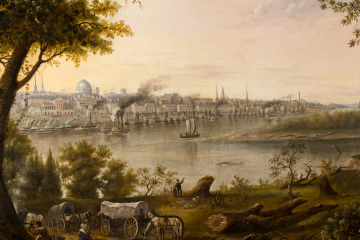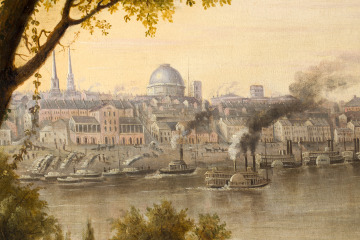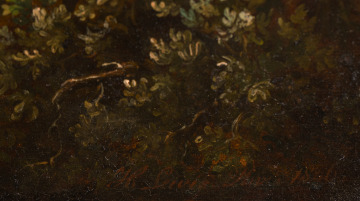Saint Louis in 1846
- Date
- 1846
- Material
- Oil on canvas
- Classification
- Paintings
- Collection
- American Art
- Current Location
- On View, Gallery 336
- Dimensions
- 32 1/4 × 42 1/4 in. (81.9 × 107.3 cm)
framed: 41 3/4 × 51 3/4 × 3 1/4 in. (106 × 131.4 × 8.3 cm) - Credit Line
- Eliza McMillan Trust
- Rights
- Public Domain
- Object Number
- 170:1955
NOTES
Steamboats crowd a riverfront lined with warehouses that extend into the distance, evidence of the bustling economy in St. Louis during the 19th century. Across the river, a wagon train has set up camp. “Bound for Oregon” is written on one of the wagons.
Henry Lewis came to St. Louis in 1836 to create scenery for the St. Louis Theatre. During his stay, he made several trips to document scenes along the Mississippi River. In 1846, Lewis likely sent this painting to New York City for exhibition. He wrote, “This view is taken from the Illinois shore, and you may rely on it being a correct one of our City as I took great pains in making the sketches and also took advantage of the Daguerreotype [an early form of photography]. . . although this city now contains a population of near forty thousand souls still the opposite shore remains in all its natural wildness.”
Henry Lewis came to St. Louis in 1836 to create scenery for the St. Louis Theatre. During his stay, he made several trips to document scenes along the Mississippi River. In 1846, Lewis likely sent this painting to New York City for exhibition. He wrote, “This view is taken from the Illinois shore, and you may rely on it being a correct one of our City as I took great pains in making the sketches and also took advantage of the Daguerreotype [an early form of photography]. . . although this city now contains a population of near forty thousand souls still the opposite shore remains in all its natural wildness.”
Provenance
James Duncan (1821–1895), St. Louis, MO [1]
William Barr Duncan (1862–1919), acquired from father, James Duncan
- 1955
William Barr Duncan, Jr. (1894–1971), Virginia, acquired from father, William Barr Duncan [2]
1955 –
Saint Louis Art Museum, purchased from Mrs. William B. (Helen Summerville Bowen) Duncan, Jr. (1897–1981) [3]
Notes:
[1] James Duncan was a partner of William Barr in a dry goods business in St. Louis in the 1850s and 1860s; he came to St. Louis around 1852 and moved from St. Louis to Virginia between 1867-1870, according to census information.
[2] According to letters from Helen Duncan to SLAM, dated May 8 and May 17, 1953, the painting descended from her husband’s grandfather, to her husband’s father, to her husband, hanging in their Virginia home, where they lived for 50 years [SLAM document files].
[3] Minutes of the Administrative Board of Control of the City Art Museum, March 3, 1955.
William Barr Duncan (1862–1919), acquired from father, James Duncan
- 1955
William Barr Duncan, Jr. (1894–1971), Virginia, acquired from father, William Barr Duncan [2]
1955 –
Saint Louis Art Museum, purchased from Mrs. William B. (Helen Summerville Bowen) Duncan, Jr. (1897–1981) [3]
Notes:
[1] James Duncan was a partner of William Barr in a dry goods business in St. Louis in the 1850s and 1860s; he came to St. Louis around 1852 and moved from St. Louis to Virginia between 1867-1870, according to census information.
[2] According to letters from Helen Duncan to SLAM, dated May 8 and May 17, 1953, the painting descended from her husband’s grandfather, to her husband’s father, to her husband, hanging in their Virginia home, where they lived for 50 years [SLAM document files].
[3] Minutes of the Administrative Board of Control of the City Art Museum, March 3, 1955.
We regularly update records, which may be incomplete. If you have additional information, please contact us at provenance@slam.org.




